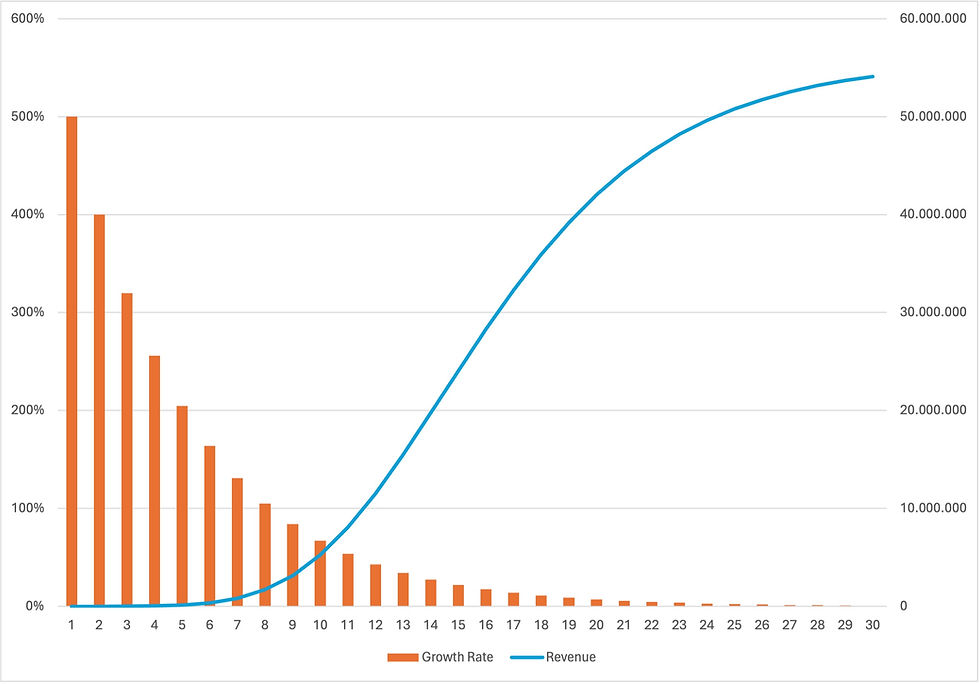Ambition ≠ Strategy ≠ Execution
- May 26, 2024
- 4 min read

Ever since I started working for or with startups more than 25 years ago I came across the same phenomena again and again: After the initial phase of hypergrowth the pace started to decelerate, targets were missed, and Sales were blamed.
What I recognized (in hindsight, I admit) is that in all these cases there was either no Growth Strategy in place or it was completely detached from the field and hence not executed.
The Situation
Here is what happens when a Disruptor enters the market with their offering: After a slow start building Product Market Fit and Go-to-Market Fit, revenues start to grow exponentially.

Once this happens more and more resources are added to the team and while the growth rate drops the absolute growth accelerates. Everybody is excited and enjoys life. Until growth slows.
The usual reaction? It is Sales’ fault! The offering is still great, the Total Addressable Market is still wide open, it must be Sales getting saturated!
What really happens:
Target Market Segment Saturation: In this case the Disruptor focussed resources on a limited number of Target Market Segments, e.g. discrete manufacturing SMBs in Germany, Austria, Switzerland, getting saturated with the Disruptive Offering.
Lack of critical mass in a Target Market Segment: The Disruptor spread their resources across a large number of Target Market Segments and missed to achieve market leadership in these. As a result, mainstream buyers turn to perceived market leaders and the Disruptor ends up as a niche player.
Maintaining hyper growth over an extended period requires the effective execution of a long-term Growth Strategy for entering and gaining a leadership position in multiple Target Market Segments. Ambition is not a strategy.
The Growth Strategy
The Growth Strategy must define the Total Addressable Market, within this the Target Market Segments to be addressed, and the resources allocated to them. Strategy decisions must be based on data and validated assumptions. The Growth Strategy must determine the north star the organization is heading for, but leave room for adaptation to new situations and the learnings of what works and what does not.
Growth Strategy execution must be instrumented to provide unfiltered, short-term feedback on its success or failure. For this the organization must agree on the terminology used to describe the strategy, its KPIs, targets and objectives.
The Absence of a Growth Strategy
An organization without a Growth Strategy can still grow for quite some time, but as it lacks a north star it is likely to grow in all directions. New Target Market Segments are entered without a careful analysis and a conscious decision. New offerings are defined by Marketing without Working Backwards from customers in defined Target Market Segments. Partnerships are established opportunistically rather than with a long-term strategic intent. Sales develops their own narratives to address the requirements of their real-world customers. The entire organization is chasing short-term results rather than building sustainable competitive advantages.
Failure to Execute a Growth Strategy
In more mature ventures I was engaged in there were rumors about and sometimes indications of the existence of a Growth Strategy, but the field was either not involved in defining it or just on the receiving end of it in the form of territory assignments, quotas, and commission systems.
The execution of a Growth Strategy happens in the Sales and Marketing organization and hence depends on the field knowing, understanding, and buying into it.
A Growth Strategy without buy-in from the field is just as good as having no strategy at all!
And here is why:
Which message Sales delivers to whom, when and how in the market is completely out of the control of management. No matter how rigid the process of managing leads in CRM: What happens in the field is documented only to a degree.
If management wants the field to execute their Growth Strategy, they must involve it in the definition phase, provide transparency on alternatives and trade-offs, and explain how decisions were made and subsequent goals and objectives established.
A Real World Example
When I joined AWS in 2013 as an Enterprise Account Manager, quota and commission was based on the invoiced revenue across all products. There were a number of objectives on top that didn’t count towards quota achievement and had no impact on commission.
For several years there was an objective on AWS’ Content Delivery Network CloudFront. And when I asked why, nobody in the organization could provide a reason. The best explanation I got was that by the time the service was launched in 2008, a clever Service Manager managed to get the objective into the system and it remained there for years for no special reason.
The problem I had with this objective was: it was completely non-strategic for my business with Fortune 500 customers in Germany and there was a strong and well-established incumbent called Akamai commanding multi-year contracts with most of my customers.
So, the question was: why should I engage in RfPs with a me-too product against a formidable competitor when I had a killer offering addressing the entire IT infrastructure budget against on-prem players that couldn’t match it, neither technically nor commercially?
I missed the objective every single year for years until CloudFront became a no-brainer add-on for my customers they just used as part of their architecture without a sales cycle.
Conclusion
Yearning for growth is regardless unless one can define a sound strategy for achieving it. But even a sound Growth Strategy is regardless unless it is translated into successful sales activities addressing real customer requirements.
In Disruption Selling we ensure execution with a closed loop approach connecting Growth Strategy with Sales and Marketing Plans and Sales Campaigns.

Comments